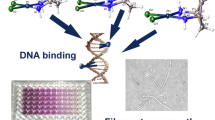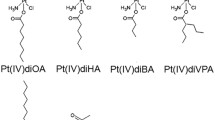Abstract
Acquired resistance is a main drawback of using cisplatin in cancer chemotherapy; however, analogs containing the 1,2-diaminocyclohexane (DACH) ligand can overcome this resistance. Because DACH can exist as thetrans-1R,2R, trans-1S,2S orcis isomer, the antitumor activity and toxicity of individual isomers of both DACH(sulfato)Pt(II) and DACH(1,1-cyclobutanedicarboxylato)Pt(II) complexes have been examined. At optimal doses, differences in antitumor activities among the three isomers were moderately dependent on the in vivo tumor models (L1210/0, L1210/DDP, B16 and M5076). However, differences in efficacy among these isomers were greatly modulated by the sulfate or 1,1-cyclobutanedicarboxylate (CBDCA) leaving ligands. Thus, thetrans isomers (R,R and/orS,S) of the sulfate complex generally had greater activities than the correspondingcis form, while thecis configuration appeared to be superior in the complex containing the CBDCA ligand. The isomers were also compared for their potential to elicit myelosuppression and kidney toxicity. Of the six isomers investigated,cis-DACH(CBDCA)Pt(II) was myelosuppressive, and the correspondingR,R andS,S isomers were mildly nephrotoxic. No such toxicities were apparent with any of the sulfate complexes. From these studies, particularly with the cisplatin-resistant L1210/DDP cell line, theR,R isomers are evidently the most interesting. However, it is possible that other leaving ligands or tumor models may indicate eitherS,S- orcis-DACH as the isomer worthy of greater interest.
Similar content being viewed by others
Abbreviations
- DACH:
-
1,2-diaminocyclohexane
- CBDCA:
-
1,1-cyclobutane-dicarboxylate
References
Borch RF (1987) The platinum anti-tumour drugs. In: Powis G, Prough RA (eds) Metabolism and action of anti-cancer drugs. Taylor and Francis, London, pp 163–193
Borch RF, Markman M (1989) Biochemical modulation of cisplatin toxicity. Pharmacol Ther 41:371–380
Burchenal JH, Kalaher K, O'Toole T, Chisholm J (1977) Lack of cross-resistance between certain platinum coordination compounds in mouse leukemia. Cancer Res 37:3455–3457
Cleare MJ (1983) Structure-activity relationships for anti-tumour platinum complexes. In: Reinhoudt DN, Connors TA, Pinedo HM, van de Poll KW (eds) Structure-activity relationships of antitumour agents. Nijhoff, The Hague, pp 59–91
Eastman A, Schulte N, Sheibani N, Sorenson CM (1988) Mechanisms of resistance to platinum drugs. In: Nicolini M (ed) Platinum and other metal coordination compounds in cancer chemotherapy. Nijhoff, Boston, pp 178–196
Geran RI, Greenberg NH, Macdonald MM, Schumacher AM, Abbott BJ (1972) Protocols for screening chemical agents and natural products against animal tumors and other biological systems (third edition). Cancer Chemother Rep 3:1–103
Harrap KR (1983) Platinum analogues: criteria for selection. In: Muggia FM (ed) Cancer chemotherapy, vol 1. Nijhoff, Boston, pp 171–217
Khokhar AR, Krakoff IH, Hacker MP, McCormack JJ (1985) The synthesis and antitumour properties of a series of water soluble carboxylato(1,2-diaminocyclohexane)platinum(II) complexes. Inorg Chim Acta 108:63–66
Khokhar AR, Lumetta G, Doran SL (1988) A convenient method for the preparation of antitumour carboxylato(1,2-diaminocyclohexane)-platinum(II) complexes. Inorg Chim Acta 151:87–88
Kidani Y, Inagaki K, Saito R, Tsukagoshi S (1977) Synthesis and antitumor activities of platinum(II) complexes of 1,2-diaminocyclohexane isomers and their related derivatives. J Clin Hematol Oncol 7:197–209
Kidani Y, Inagaki K, Iigo M, Hoshi A, Kuretani K (1978) Antitumor activity of 1,2-diaminocyclohexane-platinum complexes against sarcoma-180 ascites form. J Med Chem 21:1315–1318
Ozols RF, Hamilton TC, Reed E, Poirier MC, Masuda H, Lai G, Young RC (1988) High dose cisplatin and drug resistance: clinical and laboratory correlations. In: Nicolini M (ed) Platinum and other metal coordination compounds in cancer chemotherapy. Nijhoff, Boston, pp 197–206
Prestayko AW, Bradner WT, Huftalen JB, Rose WC, Schurig JE, Cleare MJ, Hydes PC, Crooke ST (1979a) Antileukemic (L1210) activity and toxicity ofcis-dichlorodiammineplatinum(II) analogs. Cancer Treat Rep 63:1503–1508
Prestayko AW, D'Aoust JC, Issell BF, Crooke ST (1979b) Cisplatin (cis-diamminedichloroplatinum II). Cancer Treat Rev 6:17–39
Ribaud P, Kelsen DP, Alcock N, Garcia-Giralt E, Dubouch P, Young CC, Muggia FM, Burchenal JH, Mathe G (1980) Preclinical and phase 1 studies of malonatoplatinum. Recent Results Cancer Res 74:156–162
Rose WC (1986) Evaluation of Platinol analogs using the M5076 murine sarcoma. Anticancer Res 6:557–562
Rose WC, Schurig JE, Huftalen JB, Bradner WT (1982) Antitumor activity and toxicity of cisplatin analogs. Cancer Treat Rep 66:135–146
Salem P, Khalyl M, Jabboury K, Hashimi L (1984)cis-Diamminedichloroplatinum (II) by 5-day continuous infusion. Cancer 53:837–848
Siddik ZH, Boxall FE, Harrap KR (1987) Hematological toxicity of carboplatin in rats. Br J Cancer 55:375–379
Tutsch KD, Arzoomanian RZ, Alberti D, Feierabend C, Robins HI, Spriggs DR (1992) Phase I trial and pharmacokinetic study of ormaplatin. Proc Am Assoc Cancer Res 33:536
Vollano JF, Al-Baker S, Dabrowiak JC, Schurig JE (1987) Comparative antitumor studies on platinum(II) and platinum(IV) complexes containing 1,2-diaminocyclohexane. J Med Chem 30:716–719
Weil CS (1952) Tables for convenient calculation of median-effective dose (LD50 or ED50) and instructions in their use. Biometrics 8:249–263
Author information
Authors and Affiliations
Additional information
This work was supported by NIH grant CA-41581 and in part by NIH Cancer Center (Core) support grant CA-16672
Rights and permissions
About this article
Cite this article
Siddik, Z.H., Al-Baker, S., Burditt, T.L. et al. Differential antitumor activity and toxicity of isomeric 1,2-diaminocyclohexane platinum (II) complexes. J Cancer Res Clin Oncol 120, 12–16 (1993). https://doi.org/10.1007/BF01200718
Received:
Accepted:
Issue Date:
DOI: https://doi.org/10.1007/BF01200718




